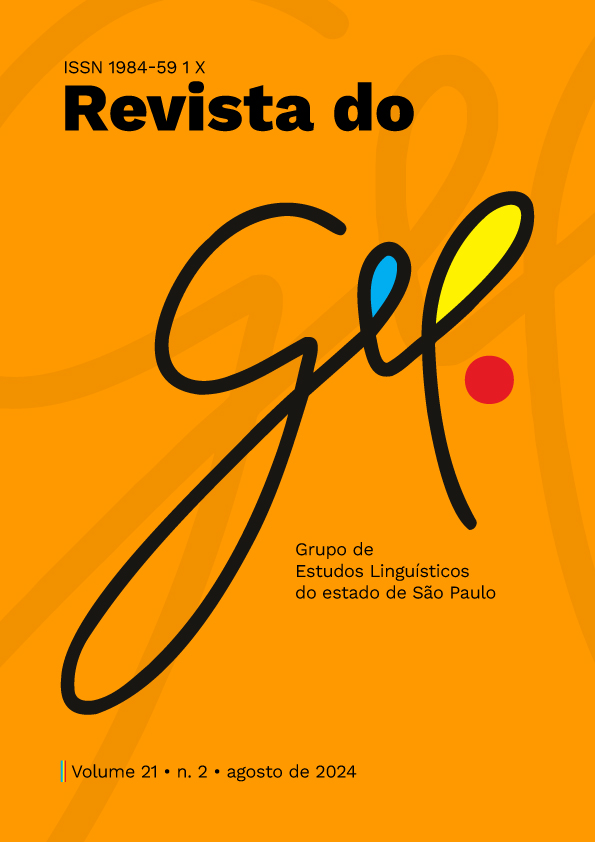Observações sobre as transformações lexicais na Libras em decorrência dos avanços tecnológicos
Observations on lexical transformations in Brazilian Sign Language (Libras) due to technological advances
DOI:
https://doi.org/10.21165/gel.v21i2.3744Parole chiave:
Lexicalização. Deslexicalização. Línguas de Sinais. Libras. Neologismo. Tecnologia. Comunicação.Abstract
A tecnologia trouxe grandes contribuições para a acessibilidade linguística da comunidade surda, impactando diretamente o léxico das línguas de sinais. Dessa forma, enquanto neologismos surgem para o vocabulário específico, outros sinais se transformam ou caem em desuso. As transformações lexicais fazem parte de um processo histórico que ocorre nas línguas naturais. Este trabalho objetiva ilustrar os processos de lexicalização, deslexicalização e neologismos na Língua de Sinais Brasileira – Libras, contribuindo para compreensão desses fenômenos linguísticos relacionados aos avanços tecnológicos. O Dicionário da Língua de Sinais do Brasil: a Libras em suas mãos (Capovilla et al., 2017) foi utilizado como corpus de análise. Após aplicação de critérios de exclusão, dos 13 mil sinais do dicionário, 80 se enquadram na categoria de “Tecnologia e Comunicação”. Os sinais selecionados foram registrados em vídeos e apresentados individualmente a quatro surdos sinalizadores. Eles apontaram os sinais que conheciam, os que desconheciam, os que caíram em desuso e os novos sinais criados. Dos 80 sinais, 10 foram considerados em desuso, por se referirem a tecnologias obsoletas, e 2 (Inteligência Artificial (IA) e Bluetooth) foram apontados como possuindo um sinal novo por dois participantes. Os resultados refletem a adaptação contínua da Libras aos avanços tecnológicos.
Downloads
Riferimenti bibliografici
ANTUNES, I. Território das palavras: estudo do léxico em sala de aula. São Paulo: Parábola Editorial, 2012.
BLÜHDORN, H.; COSTA, A. C. da. Lexicalização e deslexicalização: observações sobre a erosão da língua exemplificadas no alemão e no português do Brasil. Pandaemonium Germanicum, São Paulo, n. 3, p. 273-300, 1999. DOI: 10.11606/1982-8837.pg.1999.63984. Disponível em: https://www.revistas.usp.br/pg/article/view/63984. Acesso em: 25 mar. 2024.
BRASIL. Decreto 5.626, de 22 de dezembro de 2005. Disponível em: http://www.planalto.gov.br/ccivil_03/_ato2004-2006/2005/decreto/d5626.htm. Acesso em: 25 mar. 2024.
BRENTARI, D.; PADDEN, C. Native and foreign vocabulary in American Sign Language: A lexical content analysis. In: MEIER, R.; COHN, A.; MULLER, C. (ed.). Modality and Structure in Signed and Spoken Languages. Cambridge: Cambridge University Press, 2001. p. 22-61.
CAMPELLO, A. R.; REZENDE, P. L. F. Em defesa da escola bilíngue para surdos: a história do movimento surdo brasileiro. Educar em revista, Curitiba: Editora UFPR, ed. esp., n. 2, p. 71-92, 2014. Disponível em: http://www.scielo.br/pdf/er/nspe-2/06.pdf. Acesso em: 25 mar. 2024.
CAPOVILLA, F. C.; RAPHAEL, W. D.; TEMOTEO, J. G.; MARTINS, A. C. Dicionário da Língua de Sinais do Brasil: a Libras em suas mãos. São Paulo: EDUSP, 2017.
CRASBORN, O.; ZWITSERLOOD, I. The annotation and exploitation of a corpus of Dutch sign language. Linguistics in the Netherlands, v. 25, n. 1, p. 37-49, 2008.
FERREIRA-BRITO, L. Por uma Gramática de Língua de Sinais. Rio de Janeiro: Tempo Brasileiro/UFRJ, 1995.
JOHNSTON, T. From archive to corpus: Transcription and annotation in the creation of signed language corpora. International Journal of Corpus Linguistics, v. 15, n. 1, p. 106-131, 2010.
JOHNSTON, T.; SCHEMBRI, A. On defining lexeme in a signed language. Sign Language and Linguistics, v. 2, n. 2, p. 115-185, 1999.
LIDDELL, S. K. Grammar, Gesture, and Meaning in American Sign Language. Cambridge: Cambridge University Press, 2003.
QUADROS, R. M.; KARNOPP L. B. Língua de sinais brasileira – Estudos Linguísticos. Porto Alegre: Artes Médicas, 2004.
SANDLER, W.; LILLO-MARTIN, D. Sign Language and Linguistic Universal. Cambridge: Cambridge University Press, 2006.
STOKOE, W. Sign Language Structure: An outline of the visual communication systems of the american deaf. Studies in Linguistics, University of Buffalo, n. 8, 1960.
TEMOTEO-MARQUES, J. G.; MARTINS. A. C. (Pesquisa em andamento). Análise de sinais relacionados à Tecnologia e Comunicação: transformações lexicais na Libras. Campinas, 2023.
WILCOX, P. The phonetics of fingerspelling. John Benjamins Publishing, 1992.
WILCOX, S. The Phonetics of Fingerspelling. John Benjamins Publishing, 2000.
Downloads
Pubblicato
Come citare
Fascicolo
Sezione
Licenza
Copyright (c) 2025 Revista do GEL

Questo lavoro è fornito con la licenza Creative Commons Attribuzione - Non commerciale 4.0 Internazionale.
Esta revista oferece acesso livre imediato ao seu conteúdo, seguindo o princípio de que disponibilizar gratuitamente o conhecimento científico ao público proporciona maior democratização mundial do conhecimento.
A REVISTA DO GEL não cobra taxa de submissão ou de editoração de artigos (articles processing charges – APC).
Os critérios gerais de direitos autorais da REVISTA DO GEL estão dispostos no termo de direitos autorais que cada autor aceita ao submeter seu trabalho no periódico. Como regra geral o periódico utiliza as regras CC BY-NC da Creative Commons (regra disponível em: https://creativecommons.org/licenses/by-nc/4.0/legalcode)



